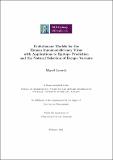| dc.contributor.advisor | Seoighe, Cathal | |
| dc.contributor.author | Lacerda, Miguel | |
| dc.date.accessioned | 2012-09-04T08:22:01Z | |
| dc.date.available | 2012-09-04T08:22:01Z | |
| dc.date.issued | 2012-02-08 | |
| dc.identifier.uri | http://hdl.handle.net/10379/2962 | |
| dc.description.abstract | In this thesis, evolutionary models are developed for protein coding sequences of the human immunodeficiency virus (HIV). These models are applied to predict the epitopes targeted by the cell-mediated and humoral arms of the immune response, and to study the natural selection of escape variants.
The first phylogenetic model that allows the codon substitution rates to depend on an arbitrary environmental variable is developed. The model is used to identify sequence positions in HIV Gag that correlate with the human leukocyte antigen genotype of the host across a phylogeny. This model is integrated with a hidden Markov model to accurately predict T cell epitopes using both evolutionary and sequence-based information.
The evolutionary model is subsequently extended to identify sites in the HIV envelope that are targeted by broadly neutralising antibodies. In particular, the model is adapted to allow the distribution of amino acids at each site to depend on neutralisation titres measured for a panel of viruses. Conformational B cell epitopes are successfully identified with a Markov chain Monte Carlo algorithm that searches the tertiary envelope structure for three-dimensional clusters of sites that collectively influence neutralisation sensitivity.
After considering HIV adaptation at the host population level, the focus then shifts to viral evolution within a host. The characteristics of transmitted viral variants are examined by analysing the breakthrough sequences from 96 monkeys experimentally infected with the simian immunodeficiency virus. Sieve analyses are performed to determine whether certain viral variants were more likely to establish infection in monkeys that received a vaccine compared to those that did not.
Finally, a maximum likelihood method is developed to estimate the population genetics parameters of HIV escape mutants from longitudinal sequence data. In contrast to previous approaches, this method permits strong selection and frequent mutation, as might be expected of intra-host HIV populations. | en_US |
| dc.rights | Attribution-NonCommercial-NoDerivs 3.0 Ireland | |
| dc.rights.uri | https://creativecommons.org/licenses/by-nc-nd/3.0/ie/ | |
| dc.subject | Phylogenetics | en_US |
| dc.subject | Molecular evolution | en_US |
| dc.subject | Human immunodeficiency virus | en_US |
| dc.subject | Epitopes | en_US |
| dc.title | Evolutionary Models for the Human Immunodeficiency Virus with Applications to Epitope Prediction and the Natural Selection of Escape Variants | en_US |
| dc.type | Thesis | en_US |
| dc.local.note | Evolutionary models are developed for protein coding sequences of the human immunodeficiency virus (HIV). These models are applied to predict the epitopes targeted by the cell-mediated and humoral arms of the immune response, and to study the natural selection of escape variants. | en_US |
| dc.local.final | Yes | en_US |
| nui.item.downloads | 146 | |


